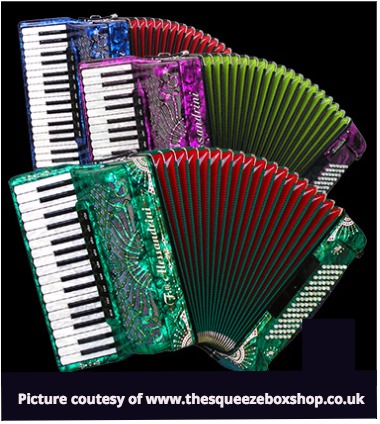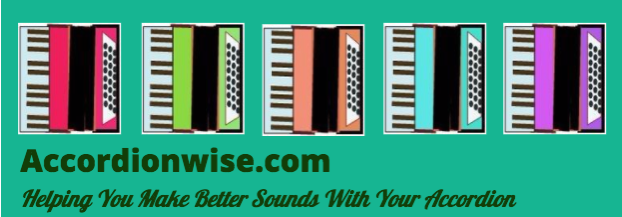I HOPE YOU ENJOY THIS WEBSITE
My name is Alex Govier, a professional musician on accordion, piano and organ for over 50 years.

On this website I am sharing stuff to
- Improve your technique
- Help you get to know your instrument better
- Play more easily and more confidently
- Try new accordion bass methods
- Integrate bass and treble sounds in different ways
- Learn how to make better music
- Gain popularity with general music listeners and not just fellow accordionists.
And yes, ALL CONTENT ON THIS WEBSITE IS FREE.
Simply because I would like more general appreciation of this wonderful instrument.
Because by playing a little more thoughtfully we can reach new audiences and get more recognition.
Find when there is new stuff on this website by joining our new Facebook Community
Here you can also
- interact with this website on Facebook
- Ask questions
- Request more detail on an accordion subject
- Suggest a new subject
- Tell us your own ideas and more.
The Accordionwise Friends link
You can find my personal playing sites on
Thinking of Buying a new Accordion?
What Your choices will give you
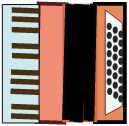 There are both your musical requirements and the accordion you find physically comfortable to use. And you need to take both factors into consideration.
There are both your musical requirements and the accordion you find physically comfortable to use. And you need to take both factors into consideration.
So here is what you will need to know. With the very small instruments choices are very simple and get more complicated and exciting to decide as you get into the territory of larger more expensive instruments.
- How many bass notes are there?
- What types of musical results does that allow you?
- How big is it?
- How heavy is it?
- How many treble keys will you have to play your tunes on?
- How many different keys can you play in?
- Are there alternative sounds you can use and if so how many
- Is there a choice of sound on the bass to allow good teble/bass balance?
- If there are three or more sets of reeds on the treble, is the tuning system what you want (from close for Jazz to extremely detuned for Scottish or French)?
- If a large expensive model does it have some sets of treble reeds in casotto for exceptional depth of tone and enhanced differences when combine with the other
With each size of accordion listed I have included the keys you should be able to play in on your choice of accordion. For the technically minded here is how I worked them out.
![]()
The exact keys you need are not important if you can transpose into one of your available keys and play by yourself, not in ensemble.
- If playing very simple major key tunes (e.g. folk tunes) you can play in any keys except those represented by the top and bottom buttons. (If bottom bass note is F you can play in any key from C upwards but not further than D if the top note is A)
- However even with the simplest tunes if you want to play in minor keys you will also need at least the major and minor key rows.
- If you want to play a full range of chords associated with that key you need to use the four buttons higher than the key button, as well of course as the note below the key name button.
However please note that due to the wide variety of instruments presented, particularly in the smaller end you should look for yourself for exactly which keys will be available on the one you are investigating.
NB The key you play in is important only if needing to follow specific written music, play with others who are already using that key, or accompany a singer or instrument to suit them.
Many players do not go beyond playing in two flats (key Bb) to two sharps (key D) and sound none the worse for it.
It can happen if there is a change of key inside a song which started in a very "safe" key however!
For the moment we will assume that it is a piano accordion that you want rather than a chromatic or diatonic one (which has buttons on both sides).
Chromatic accordions can fit in a much wider range on the treble side because the chromatic buttons are configured to take up less space than on a piano style keyboard. Chromatic keyboards can cover more notes than a five octave syunthesiser keyboard in fact at the higher end of accordion size.
![]()
Advantages of larger instruments
With the larger instruments there is a possibility that they may include any of the following. The more expensive, the more there may be such options, but do not assume they are there unless you check!
- Wider range of treble notes because of physical size allowed by the number of bass buttons
- Choice of sounds from more than one "register" in the treble
- Different sounds available in bass for balance and contrast with the treble sounds
- Three sets of treble reeds with 5 or more tabs with two on the middle range on on the lower octave will give you access to the main styles of sounds usually suggested for jazz, tango/latin, French musette or folk, polka, popular and playing for sheer volume!
- Four sets of reeds give you a choice of configurations to include either an extra middle octave reed for enriched musette tones and different detuned tremolos OR an extra high octave reed for very bright tones and more tab possibilities.
- With Four sets of reeds you should also be very aware of the type of tuning, between dry (Virtually no detuning of the middle reed) for jazz and classical to coarse such as Scottish or French. Listening to the exact sound is recommended.
- Not all accordions have piano size keys, some are slightly smaller described as compact size or previously as ladies size, still playable unless you have very thick fingers and very large hands. Then you have a lighter more compact instrument, although the bellows will also be smaller for a very slight effect on the number of notes you can play in each direction.
- On 120 bass instruments you can also buy models with 45 note treble keyboards for super serious professional use. Note that even on 96 and 120 bass models there may be variations of actual notes you have. For 96 bass you can usually expect three octaves A to A or F to F and for 120 bass mostly at three octaves plus or at least F to A
- On 120 bass and occasionally 96 bass you may have the option of one or two sets of reeds in cassotto boxes giving richer deeper tones and enhanced differences as they are mixed in the tabs with the normal unenclosed reeds
- 120 bass instruments are larger and heavier but if you mainly play sitting down it should not make too much difference once you are comfortably seated with the instrument.
PLAYING TIP
Particularly if playing standing up using a Back Strap gives you more control and comfort. You may need a friend to fasten it behind you however.
These are often incorporated in modern accordion straps or if not readily and inexpensively available to hook across between the right and left hand straps.
![]()
The 12 bass accordion
If you ever pick up a 12 bass instrument and have any knowledge of the piano keyboard it will instantly get you playing instantly, but is extremely musically limited, with only six different major chords you can play along with the bass note of the same name beside them.
Great to give you confidence, but aside from that only suitable longer term for very small children, who will find them very light and easy to handle.
Further downsides are that there is room for very few treble keys, probably only just a little more than once octave and that the bellows will also have little power or stamina to keep a tune going continuously.
It will also only give you only one sound, usually a very light one with no vibrato.
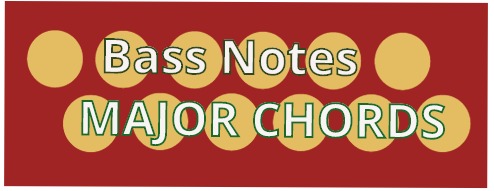
SUMMARY:
You will like the 12 bass for its instant playability but will very quickly realise its limitations and your need to go bigger and better, I would say to at least 48 bass, possibly 72, or for additional reasons to the rather substantial 96 or 120 button accordions.
![]()
The 24 bass accordion
Please note the number and placing of the bass notes and the number of treble keys is not standard on these very small instruments, so check in individual instruments you are looking at.
The number of treble piano style notes will be increased as the manufacturer makes them smaller to fit in more. This is unlikely to be a very good action to play on, though these might be suitable for very small children.
Even so it is better if you can leap ahead to a 48 bass. Those with smaller keys can accomodate quite a reasonable range of notes.
| No. of Bass Notes | 24 button | No. of Rows | Three rows |
| Estimated Key range | Bass Keys Bb to A | Playable in Keys | F to E (or F&C) |
| No of treble notes | varies estd 15-24 | Range of treble | max 2 8ves |
| No. of treble reeds |
Up to 2 |
Treble Tabs/Sounds | Max 2 |
| Bass button types |
Notes, Major, minor |
No. of Treble Notes | 25 or fewer |
| Bass Registers | N/A | Bass reed sets | max 2 |
| Cassotto reed boxes | N/A | Bellows | Limited |
Note the advice on bellows being limited refers to only a small amount of air, probably only sufficient for a couple of notes at a time, or a very short fast phrase.
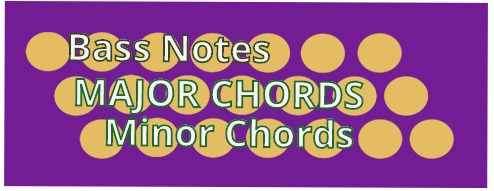
![]()
The 32 bass accordion
Please note the number and placing of the bass notes and the number of treble keys is not standard on these very small instruments, so check any individual instruments you are looking at. This affects for example the advice as to the exact keys you can play in.
The number of treble piano style notes was increased when the manufacturer mades them smaller. So they could fit more notes onto the instrument. This is unlikely to be a very good action to play on, though these might be suitable for very small children.
Even so it is better if you can leap ahead to a 48 bass. Those with smaller keys can accomodate quite a reasonable range of notes.
| No. of Bass Notes | 32 button | No. of Rows | Four rows |
| Estimated Key range | Bass Keys Bb to A | Playable in Keys | F to E (or F&C) |
| No of treble notes | varies estd 15-24 | Range of treble | max 2 8ves |
| No. of treble reeds |
Up to 2 usually |
Treble Tabs/Sounds | Max 2 usually |
| Bass button types |
Counterbass, Bass Maj min |
No. of Treble Notes | Average 25 |
| Bass Registers | N/A | Bass reed sets | max 2 |
| Cassotto reed boxes | N/A | Bellows | Limited |
An advantage of the 32 bass is the extra row of counterbass notes, which allow the bass line to be varied in the same way as on the largest instruments. It also allows for a much more complete learning process. Therefore it is better to learn on.
However the number of keys you can play in is still severely limited, five keys if satisfied with the most basic chords, or three being able to cope with
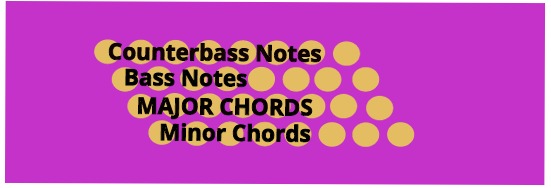
Note the advice on bellows being limited refers to only a small amount of air, probably only sufficient for a couple of notes at a time, or a very short fast phrase.
![]()
The 48 bass accordion (1)
This is the older version of the 48 bass and you are more likely to find the other version following. This version would allow you to play, including all the required minor chords in seven different keys.
The warnings I put about the previous instruments still apply but this instrument would enable you to play in a remarkable seven different keys, using all the relevant minor chords for the keys you were playing in
.
| No. of Bass Notes | 48 button | No. of Rows | Four rows |
| Estimated Key range | Bass Keys Db to F# | Playable in 7 Keys | Ab to D incl |
| No of treble notes | varies estd 15-24+ | Range of treble | max 2 8ves |
| No. of treble reeds |
2 |
Treble Tabs/Sounds | Likely 2 |
| Bass button types |
Counterbass, Bass Maj min |
No. of Treble Notes | 25 or fewer |
| Bass Registers | Usually N/A | Bass reed sets | max 3 |
| Cassotto reed boxes | N/A | Bellows | A bit Limited |
As it contains two rows of bass notes it also allows you to learn properly as on the 32 note, and as on the biggest instruments. You cannot play sevenths chords and diminished however as the rows for these are missing.
Smaller size keys are still essential to fit a meaningful size treble keyboard at this size. Even right up to the 72 note instruments.
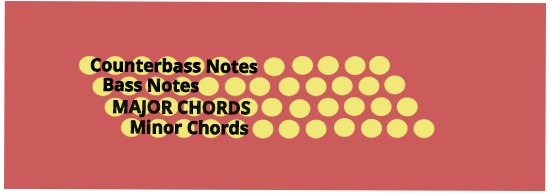
Piano style notes are likely to be made very much smaller than standard to fit onto this instrument becasue of its compact size and the requirement for a reasonable range of notes.
Bellows will be limited for power and sustaining ability, but it is possible you may have control over the tone, with 3 registers giving two different sounds of either one or two reeds, usually tremolo or straight (organ like) sounding.
The 48 bass accordion (2)
This seems to be the more common form of modern 48 bass accordion and has the benefit of containing all types of chords and bass notes. This has to be at the expense of fewer keys you can play in of course, I calculate four different keys possible to play if they are to able to contain all the minor chords for those keys. Six keys if you are content to be a three chorder. The same number of minor keys in those categories also fof course.
It is a very light and compact size which responds well to lively playing, but of course is very limited as to keys you can play fully in.

You will of course have to make sure you have smaller style keys or there will be very few notes to choose from. Not necessarily a bad thing to have smaller keys as long as you do not have hands like shovels, and if it is your only accordion to practice on, so you are not distracted by different gaps on different instruments.
| No. of Bass Notes | 48 button | No. of Rows | Six rows |
| Estimated Key range | Bass Keys Eb to E | Playable in 6 or 4 Keys | Bb-A or to G |
| No of treble notes | varies estd 15-24 | Range of treble | max 2 8ves |
| No. of treble reeds |
2 or 3 |
Treble Tabs/Sounds | Max 5 |
| Bass button types |
All six available |
No. of Treble Notes | 25 or fewer |
| Bass Registers | N/A | Bass reed sets | max 3 |
| Cassotto reed boxes | N/A | Bellows | A bit Limited |
Some will have five tabs for three reed sets. Occasionally two bass registers.
![]()
The 60 bass accordion
Until recently I ignorantly despised the 60 and 80 bass models but only recently discovered that their main limitations of not having a sixth row to give diminished chords are easily overcome.
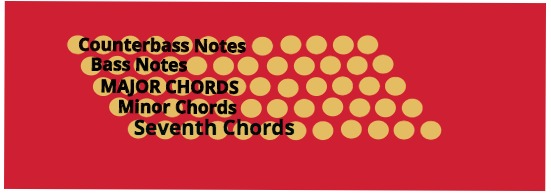
The range of playable keys you can play in is impressive with its 12 by 5 format. The same as a 72 bass in fact. It shares with the 72 bass the requirement to have smaller size keys, or you will be stuck with as few as two octaves to play on the right hand keyboard.
| No. of Bass Notes | 60 button | No. of Rows | Five rows |
| Estimated Key range | Bass Keys Db to F# | Playable in 7 Keys | Ab to D incl |
| No of treble notes | varies estd 15-24 | Range of treble | min 2 8ves |
| No. of treble reeds |
2 |
Treble Tabs/Sounds | Likely 2 |
| Bass button types |
Counterbs-Bass-Maj-min-7th |
No. of Treble Notes | 25 upwards |
| Bass Registers | Possibly | Bass reed sets | max 3 |
| Cassotto reed boxes | N/A | Bellows | Reasonable |
But it has no diminished chords right? Literally yes, but it is very practical to use the seventh row in their place, or if it is a model with diminished chords as the fifth row you can use those for major 7th chords.
They are not exactly the same chords but compatible with that harmony. As a matter of fact even a 120 bass accordion does not have true diminished chords, but chords that become diminished according to what treble notes you play with them.
To find diminished chords from the fifth row when it is (as is probably mostly the case) 7th chords, play the key below. For C dim play F7, D dim play G7, F dim play Bb7 etc.
For 7th chords if the fifth row contains diminished, go one up on that row. For C7 play G dim, D7 play A dim, Bb7 play F dim etc.
![]()
The 72 bass accordion
This is a nice standard size acordion with two warnings to watch out for.
Unless the cabinet has been built a little oversize or the keys smaller than standard it will have less than two octaves in the treble. IT is common for this to be done however.
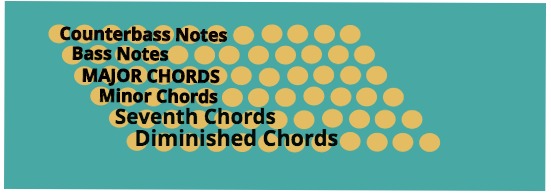
Also, depending on the exact location of the C bass button in the layout, you may find yourself playing a C# chord (or possibly more likely a C# minor chord) and wanting a C# or C#minor chord to follow it, AND IT ISN'T THERE!
You will have to go to the extreme bottom end of the bass keyboard to find the subsitute D flat chord. A long way, but at least easy to find since there is just a big gap below it.
| No. of Bass Notes | 72 button | No. of Rows | Six rows |
| Estimated Key range | Bass Keys Db to C# | Playable in 6 or 4 Keys | Bb-A or to G |
| No of treble notes | varies estd 25+ | Range of treble | From 2 8ves |
| No. of treble reeds |
2 or 3 |
Treble Tabs/Sounds | Max 5 |
| Bass button types |
All six available |
No. of Treble Notes | 25 or fmore |
| Bass Registers | N/A | Bass reed sets | max 3 |
| Cassotto reed boxes | N/A | Bellows | A bit Limited |
Some will have five tabs for three reed sets. Occasionally two bass registers from 3 tabs, usually giving you vibrato (two reeds playing) or non vibrato single reed sound. If there are three switches, the two outside ones will be the same, for the single reed sound.
![]()
The 80 Bass Accordion
This is an instrument size which is almost on a par with the 120 bass accordion. Only lacking the (not totally essential) sixth bass row but with the same number of keys possible to be played in.
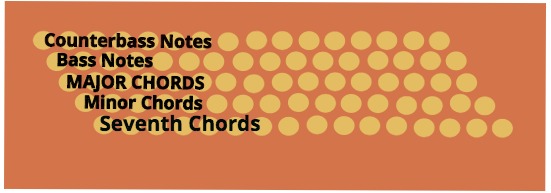
Here there is a 20 key range in five rows. This means that the treble note range can be the same as a 120 bass, up to 41 notes .
| No. of Bass Notes | 60 button | No. of Rows | Five rows |
| Estimated Key range | Bass Keys Db to F# | Playable in 7 Keys | Ab to D incl |
| No of treble notes | varies estd 15-24 | Range of treble | min 2 8ves |
| No. of treble reeds |
2 |
Treble Tabs/Sounds | Likely 2 |
| Bass button types |
Counterbs-Bass-Maj-min-7th |
No. of Treble Notes | 25 upwards |
| Bass Registers | Possibly | Bass reed sets | max 3 |
| Cassotto reed boxes | N/A | Bellows | Reasonable |
Once again this has no visible diminished chords (or occasionally no 7th chords), but it is very practical to use the seventh row in their place,.
They are not exactly the same chords but compatible with that harmony.
To find diminished chords from the fifth row when it is (as is probably mostly the case) 7th chords, play the key below. For C dim play F7, D dim play G7, F dim play Bb7 etc.
For 7th chords if the fifth row contains diminished, go one up on that row. For C7 play G dim, D7 play A dim, Bb7 play F dim etc.
![]()
The 84 bass Accordion
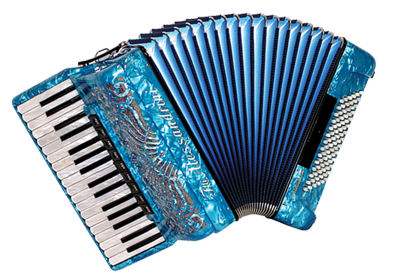 This is an innovative solution of how to combine lightness and compactness, marketed by The Squeezebox Shop Yarrow, Hughton, By Beauly, Inverness IV4 7JN
This is an innovative solution of how to combine lightness and compactness, marketed by The Squeezebox Shop Yarrow, Hughton, By Beauly, Inverness IV4 7JN
A full three octave treble keyboard and a bass range big enough to cover that awkward place where you run out of the main sharp keys at the top and have to go to the bottom of the bass buttons to the flat section to fill in!
![]()
The 96 bass accordion
The 96 bass accordion is a slightly smaller version of the 120 bass, having 16 different named chord keys instead of 20, so usually has a matching treble range of 37 keys F to F or A to A, though this can vary and by making the keys smaller it can match the 41 treble keys of its big brother.
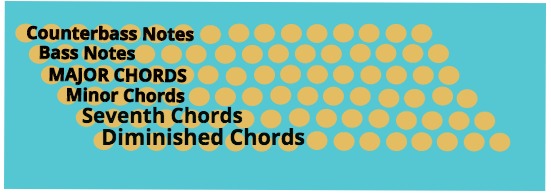
Some manufacturers manage to squeeze cassoto boxes into the 96 bass cabinet, though it is fairly unusually. I very much doubt you will find a 5 voice 96 bass however.
The same possibilites of tuning variation between octave tuned L M M+ H or musette tuned L M- M M+ are available and different tuning systems from dry to Scottish or French tuning is available.
An accordion of the same specification but different tuning systems will sound totally different on most registers, though theoretically identical when using those without detuned reeds.
![]()
The 120 bass accordion
At first glance this does not seem to be very different than the 96 bass diagram, but tot fit on the page the buttons have been made a little smaller and closer. At 20 keys by 6 rows it covers 4 extra playing keys to the 96 bass.
On the treble side 41 keys is standard, usually low F to high A. Exceptionally large instruments can have a treble range of 45 notes from low E to high C. This can be accomplished with smaller keys, a bigger cabinet, or by an extended keyboard section. (OR possibly a combination of the last two possibilities).
By the time you get here you have so many possibilities, though rather a large instrument. Do you want one in an Octave tuning i.e. Lower octave-Middle Octave-Middle Octave detuned-Higher Octave LMMH format or in Musette form with one octave and three middle octave (two sets of reeds detuned above and below)
After that you can still change what it sounds like, according to your preferred repertoire, or personal sound choice, from dry tuning for jazz or classical, up to general tuning, or the extremely wide French or Scottish tuning.
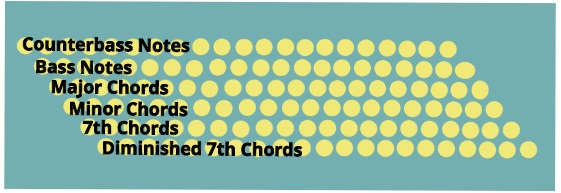
My own lovely classic Italian made Victoria A420V accordion is shown below, as you can see 120 bass buttons (16 keys rows by 6 "types"), 41 treble piano style keys low F to high A, 15 treble registers, all different and distinctive sounding thanks to two voice lower and middle pitch being in casotto and the addition of some combinations without the standard in tune middle casotto sound, hence clearer and brighter. Also seven sonorous bass registers to complete and build up the sound magnificently. (You may gather I rather like this one).
It is octave tuned not musette tuned and set at a modest 10 per cent detuning for a light vibrato. If I had specified a 5 voice treble I could have incorporated both octave and musette registers, but this would have made it a little heavier I think.
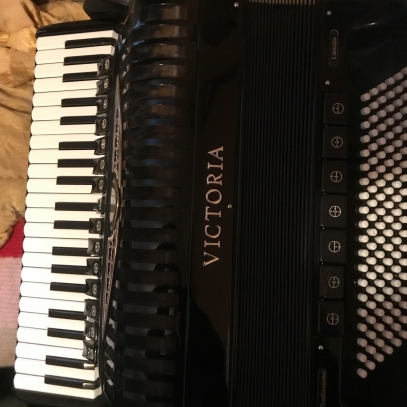
Victoria are famous also for the all wood finish Poeta model as made famous by Frank Marooco and the cbromatic Richard Galliano version in a similar black finish to mine.
Only some have the reeds in casotto of course like mine, nor the 15 treble registers or 7 bass registers. Up to 12 treble is more common and also 3 or 5 bass registers. However some manufacterers, Victoria included, produce models with an extended treble range of E to high C, useful for extra free ranging arpeggios etc, though even on the finest reeds I think the sound gets a little thin from high F and upwards.

